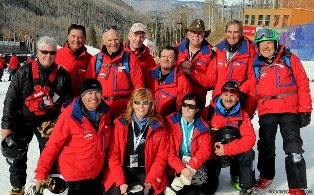Navajo, Hopi activists push for stiffer pollution controls at coal plant creating haze at Grand Canyon
During public meetings in Phoenix the last two days, activist groups have been rallying support for looming U.S. Environmental Protection Agency (EPA) clean-air regulations that would compel the plant to install the best retrofit technology available to scrub nitrogen oxide emissions from its smokestack. Besides respiratory problems for area residents, critics blame the 42-year-old power plant for haze over Grand Canyon National Park.
Last month the EPA ordered major pollution controls within five years at San Juan Generating Station 15 miles west of Farmington, N.M., ordering the facility to reduce nitrogen oxide emissions by 80 percent. Colorado lawmakers were seeking to avoid similar federal regulations when they approved the Clean Air, Clean Jobs Act that requires the conversion of aging coal-fired power plants on the Front Range to natural gas or renewable energy.

Conservation groups say the Department of Interior -- whose Bureau of Reclamation owns the largest chunk of the Navajo power plant – is pressuring EPA to delay its ruling until the Golden, Colo.-based National Renewable Energy Laboratory (NREL) can complete the first phase of an overall study on operations at the Navajo Generating Station. The plant, collectively owned by the Salt River Project, provides electricity in Arizona, Nevada and California and also supplies power to pump water through the Central Arizona Project.
“The pollution, health, and water impacts of Navajo Generating Station are huge costs -- human and financial and environmental,” said Nikke Alex, a member of the Navajo Nation. “The fact that they're ignored in the Department of Interior's study is glaring and should be alarming for everyone in our region. Since the Department of Interior owns so much of this plant, there's concern they may be using their influence to avoid an accounting of the true costs of keeping it running.”
As many as 18,000 homes on the Navajo Nation are completely off the grid despite the presence of nearby coal-fired power plants, which local health officials blame for a wide range of respiratory problems. But Republican lawmakers from Arizona have been actively trying to thwart the EPA push for cleaner air in the region, holding hearings and targeting various congressional committees.
U.S. Reps. Paul Gosar and Trent Franks sent a letter to the Natural Resources Subcommittee on Water and Power and the Subcommittee on Indian and Alaska Native Affairs arguing the EPA regulations could cost jobs and endanger the state's power and water supply. They blasted what they deemed “burdensome regulations that threaten the viability of the plant.”
“The plant and associated mine provides nearly 1,000 jobs in northern Arizona, is critical to the livelihood of the Pinal County and Native American agricultural community, and is essential to supplying water to 80 percent of the state's population,” Gosar said. “We must carefully examine regulations that could threaten the state of Arizona's water and power supply.”
Navajo and Hopi activists counter that they've suffered greatly from increased asthma and other respiratory problems traced to the plant. They also pointed to a study by the American Lung Association that found the Phoenix metro area is “one of the 25 worst of 277 U.S. metro areas for ozone pollution and is the second worst area in the nation for year-round exposure to fine particle pollution.”
Still, Navajo plant operators have reportedly indicated they might have to shutter the facility if the EPA requires the retrofits, which critics claim could unnecessarily cost more than $1 billion.
![]() 0 Comments on "Navajo, Hopi activists push for stiffer pollution controls at coal plant creating haze at Grand Canyon"
0 Comments on "Navajo, Hopi activists push for stiffer pollution controls at coal plant creating haze at Grand Canyon"
Be the first to comment below.


 Vail Town Council to weigh new plan to redevelop T...
Vail Town Council to weigh new plan to redevelop T...  All about indexes
All about indexes  Transforming your social security into a winning r...
Transforming your social security into a winning r...  Pass sales, real estate transactions, revenues inc...
Pass sales, real estate transactions, revenues inc...  Vail Valley native with passion for Biophilic inte...
Vail Valley native with passion for Biophilic inte...  Beaver Creek starts work on new summer activities
Beaver Creek starts work on new summer activities  Land Trust, ECO Trails, Vail Resorts team up to cl...
Land Trust, ECO Trails, Vail Resorts team up to cl...  EUROVISION named Host Broadcaster for 2015 World A...
EUROVISION named Host Broadcaster for 2015 World A...  Vail Resorts brings back Lindsey Vonn's 'School of...
Vail Resorts brings back Lindsey Vonn's 'School of...  Hundreds turn out for 2015 World Championships vol...
Hundreds turn out for 2015 World Championships vol...  Eagle County Senior Health Expo and 9th Annual Hea...
Eagle County Senior Health Expo and 9th Annual Hea...  Final race of Vail Mountain Trail Running Series s...
Final race of Vail Mountain Trail Running Series s...  Before you write your will ...
Before you write your will ...  2015 World Ski Championships volunteer recruitment...
2015 World Ski Championships volunteer recruitment...  Ascent Sotheby’s International Realty in Vail an...
Ascent Sotheby’s International Realty in Vail an...  CDOT outlines road closures for local stages of US...
CDOT outlines road closures for local stages of US...  Italian artist creates unique trophies for Vail, B...
Italian artist creates unique trophies for Vail, B...  Vail Recreation District once again hosting Jake W...
Vail Recreation District once again hosting Jake W... 

